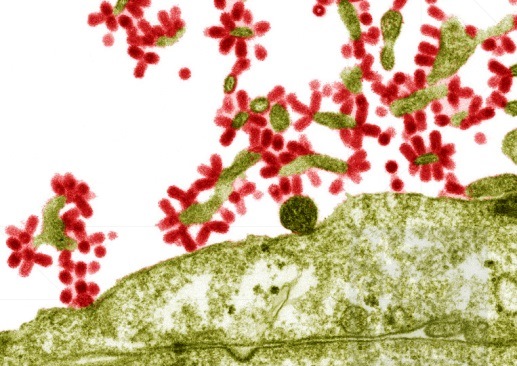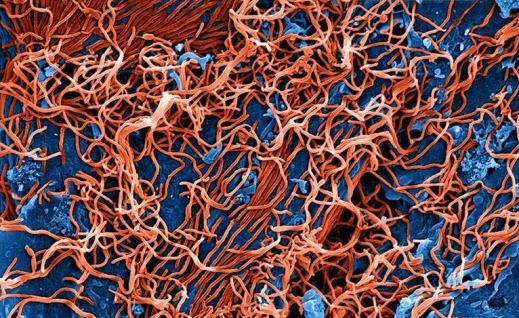Key Concepts
A pathological condition spread among all biological species. Infectious diseases are caused by a pathogen that invades and then grows and multiplies in the body of an organism. Infectious diseases, although varied in their effects, are always associated with viruses (Fig. 1), bacteria, fungi, protozoa, multicellular parasites, and aberrant proteins known as prions. A complex series of steps, mediated by factors contributed by both the infectious agent and the host, is required for microorganisms or prions to establish an infection or disease. Worldwide, infectious diseases are one of the leading causes of human death. See also: Bacteria; Disease; Epidemiology; Fungi; Infection; Medical bacteriology; Medicine; Parasitology; Pathogen; Prion disease; Protozoa; Public health; Virus

Pathogenic microorganisms
It is difficult to group microorganisms as exclusively commensal or pathogenic species. The most common relationship between a host and a microorganism is a commensal one, in which advantages exist for both organisms. For example, hundreds of billions of bacteria of many genera live in the human gastrointestinal tract, coexisting in ecological balance without causing disease. These bacteria help prevent the invasion of the host by more virulent organisms (for example, Salmonella, Shigella, or Campylobacter species). In exchange, the host provides an environment in which harmless bacteria can readily receive nutrients to fulfill their metabolic needs. There are very few microorganisms that cause disease every time that they encounter a host. Instead, many factors of both host and microbial origins are involved in infectious disease. These factors include the general health of the host, previous exposure of the host to the microorganism, and the complement of molecules produced by the bacteria. See also: Human microbiota; Microbiome; Mutualism; Symbiosis
Infectious disease transmission
Spread of a pathogenic microorganism among individual hosts is the hallmark of an infectious disease. This process, known as transmission, may occur through four major pathways: contact with the microorganism, airborne inhalation, through a common vehicle such as blood, or by vector-borne spread.
Contact spread
In contact-spread disease, the host is in direct or indirect contact with the infectious agent. Most sexually transmitted diseases are spread by direct contact with the microorganism from an infected host. Indirect transmission occurs via an inanimate object that carries the infecting organism, as in the spread of infections resulting from the sharing of needles among intravenous drug abusers. Another route of transmission involves spread by droplets, which are relatively large particles coughed or sneezed into the air. The droplets are usually broadcast within a few feet of the infected host and transmitted to a susceptible individual nearby. Notable diseases cause by droplets include streptococcal pharyngitis (strep throat), measles, and COVID-19 (coronavirus disease 2019). See also: Coronavirus; Measles; Novel coronavirus is declared a global pandemic; Sexually transmitted diseases; Streptococcus
Airborne spread
Transmission through the air (beyond a few feet from the infected host) occurs when microorganisms attach to dust particles or when they are contained in aerosols. Particles may remain suspended in the air for hours or days, and they can be inhaled if they are of the appropriate size. Tuberculosis (Mycobacterium tuberculosis) and chickenpox (varicella zoster virus) are examples of diseases transmitted by the airborne route. See also: Chickenpox and shingles; Tuberculosis
Common-vehicle spread
Persons can become infected following contact with a contaminated common vehicle, such as food, water, or blood. For example, transmission of the Ebola virus (Fig. 2) occurs through direct contact with a sick person's body fluids (for example, blood, vomit, sweat, or diarrhea). Various toxins, including Escherichia coli toxins, mycotoxins (fungal toxins), Clostridium botulinum toxins, and the Staphylococcus aureus enterotoxins, are spread primarily through the ingestion of contaminated food products. The infectious agents of spongiform encephalopathies, such as mad cow disease, are known as prions and are transmitted through contaminated feed. Typhoid fever, cholera, and amebic dysentery are examples of illnesses acquired through contaminated drinking water. Hepatitis B and acquired immune deficiency syndrome (AIDS) are examples of viral diseases spread by transfusion with infected blood. See also: Acquired immune deficiency syndrome (AIDS); Botulism; Cholera; Clostridium; Ebola virus; Escherichia; Food poisoning; Hepatitis; Mycotoxin; Staphylococcus; Waterborne disease

Vector-borne spread
Transmission of microorganisms can occur through an intermediate vector, such as an insect or other arthropod. Often, the intermediate host is a necessary agent, serving an essential biological role in the microorganism's life cycle. For example, mosquitoes spread the malaria-causing protozoan Plasmodium falciparum and the yellow fever arbovirus as they transmit infected blood from one mammal to another. Spotted fever (caused by Rickettsia rickettsii) and Lyme disease (caused by the spirochete Borrelia burgdorferi) are transmitted via the bite of an infected tick. See also: Arboviral encephalitides; Lyme disease; Malaria; Yellow fever
Pathogenesis of infection
The manner in which an infectious disease develops, or its pathogenesis, usually follows a consistent pattern. To initiate an infection, there must be a physical encounter in which the microorganism enters the host. The most frequent portals of entry are the respiratory, gastrointestinal, and genitourinary tracts, as well as breaks in the skin. Surface components on the invading organism determine its ability to adhere and establish a primary site of infection. The cellular specificity of adherence of microorganisms often limits the range of susceptible hosts. For example, although measles and distemper viruses are closely related, dogs do not get measles and humans do not get distemper. From the initial site of infection, microorganisms may directly invade further into tissues or travel through the blood or lymphatic system to other organs. See also: Canine distemper
Microorganisms produce toxins that can cause tissue destruction at the site of infection, can damage cells throughout the host, or can interfere with the normal metabolism of the host. The damage that microorganisms cause is directly related to the toxins that they produce. Toxins are varied in their mechanism of action and host targets. For example, Staphylococcus aureus can express several toxins that destroy tissue near its site of entry into the body, leading to the formation of boils, carbuncles, and abscesses.
Response to infection
The host's reaction to an infecting organism is the inflammatory response, which is the body's most important internal defense mechanism. Although the inflammatory response is also seen as secondary to physical injury and nonspecific immune reactions, it is a reliable indicator of the presence of pathogenic microorganisms. Inflammation is characterized by the cardinal signs of heat, redness, swelling, and pain. Moreover, immune cells known as lymphocytes and granulocytes are carried by the blood to the site of infection. These cells engulf and kill microorganisms, or they secrete substances that inhibit and neutralize microorganisms. Other white blood cells, primarily monocytes, recognize foreign organisms and transmit chemical signals to other cells of the host's immune system, triggering the production of specific antibodies or specialized killer cells, both of which are lethal to the infecting microorganism. Any influence that reduces the immune system's ability to respond to foreign invasion, including radiation therapy, chemotherapy, or destruction of immune cells by an immunodeficiency virus, increases the likelihood that an organism will cause disease within the host. See also: Antibody; Immunology; Inflammation
Infectious disease control
Chemical compounds that are more toxic to microorganisms than to the host are commonly employed in the prevention and treatment of infectious disease. These drugs kill bacterial, viral, fungal, or protozoan pathogens without harming their human host. However, the emergence of drug-resistant organisms has led to increases in the morbidity and mortality associated with some infections. Other methods for controlling the spread of infectious diseases are accomplished by breaking a link in the chain of transmission between the host, microorganism, and mode of spread by altering the defensive capability of the host. Overall, the most important advances to extend human life are clean water, vaccination, antibiotics, and proper methods of food handling. See also: Drug resistance; Food microbiology; Foodborne disease; Vaccination; Water treatment





